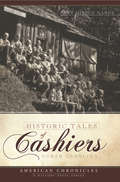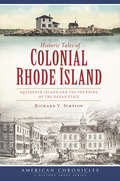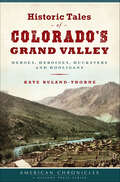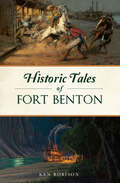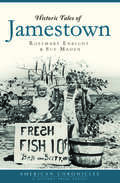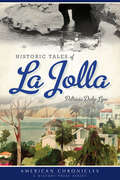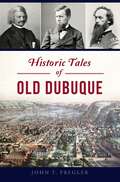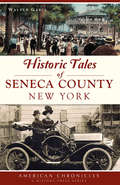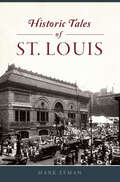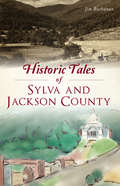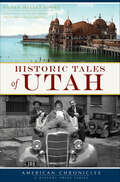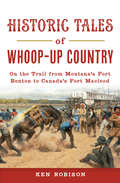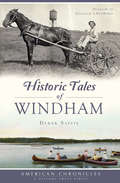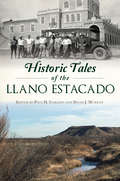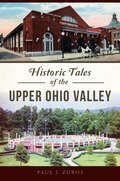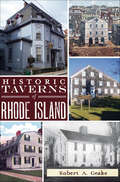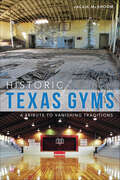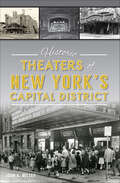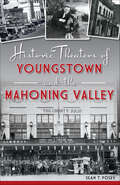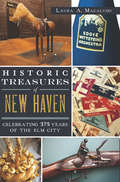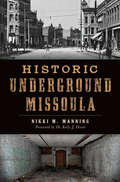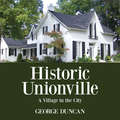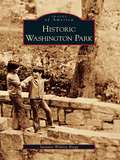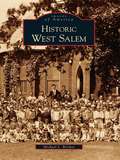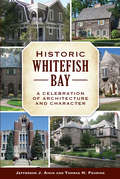- Table View
- List View
Historic Tales of Cashiers, North Carolina
by Jane Gibson NardyIn this charming account, North Carolina historian Jane Gibson Nardy recounts a treasure-trove of true stories from her beloved Blue Ridge community. In addition to several generations of family memorabilia from her personal library, Nardy has also culled the area's public records--deeds, wills, marriage registers and even tombstones--all of which help to create a vivid picture of mountain life in the nineteenth and early twentieth centuries. Some of the tales will amuse and some will sadden, but all will educate you about the wonderful heritage of Cashiers.
Historic Tales of Colonial Rhode Island: Aquidneck Island and the Founding of the Ocean State
by Richard V. SimpsonRoger Williams purchased the fertile Aquidneck Island from the Narragansett tribe in 1637. It was here that Anne Hutchinson, along with William Coddington and other colonists who had been banished from the Massachusetts Bay Colony, found shelter from persecution. The intrepid dissenters of Rhode Island Colony saw their community flourish with the founding of Portsmouth and Newport townships. The Battle of Rhode Island was the only clash between American colonials and the British on Rhode Island soil during the Revolutionary War. From the mercantile success of the Atlantic triangle trade routes to the establishment of the United States Navy, noted historian Richard V. Simpson brings these and other stories from the Ocean State to life. Join Simpson as he explores the landmarks and architecture of the period to discover the remnants of Rhode Island's colonial past.
Historic Tales of Colorado’s Grand Valley: Heroes, Heroines, Hucksters and Hooligans (American Chronicles)
by Kate Ruland-ThorneColorado's Grand Valley has an extensive geological and human history going back millennia. Franciscan priests worked in tandem with the native Ute people to plot passage through the territory, opening the valley to unprecedented settlement. The region became the playground of enterprising visionaries, murderous outlaws, hooligans and harlots alike. From the gruesome Meeker massacre and its tragic consequences for the Ute nation to the mysterious murder of Sam McMullin and a showdown with the Ku Klux Klan in 1925, uncover the engrossing stories of an unyielding land. Author Kate Ruland-Thorne recounts many of the defining and damning moments throughout Grand Valley history.
Historic Tales of Fort Benton (American Legends)
by Ken Robison"…more romance, tragedy and vigorous life than many a city a hundred times its size and ten times its age." - Historian Hiram M. Chittenden Deep in the heart of Blackfoot country on the Upper Missouri River, trade relations opened cautiously in 1831. A series of trading posts and clashes followed. By 1846, Fort Benton had become the center of commerce with Indigenous tribes, including the Blackfoot who dubbed it "many houses to the South." Drawing settlers from eastern states, the head of steamboat navigation became known as "the world's innermost port." As a result, the fort became a multicultural melting pot and home to the "Bloodiest Block in the West." Award-winning historian Ken Robison brings to life dramatic sagas of a rapidly developing frontier, from vigilante X. Beidler to the Marias and Ophir Massacres.
Historic Tales of Jamestown (American Chronicles)
by Sue Maden Rosemary EnrightDiscover the fascinating history of Jamestown, from tales of shipwrecks to summer days long past. The town was home to Camps Bailey and Meade, two training facilities for Union troops during the Civil War. When the steam ferries crossed the bay beginning in 1873, people traveled to the island to sample the town's leisure and entertainment opportunities. Beavertail Lighthouse and the breathtaking Clingstone stand as iconic landmarks centuries after their construction. After the Jamestown Bridge opened in 1940, suburban development on the North End mostly replaced the hotels along the waterfront. Local authors Rosemary Enright and Sue Maden reveal stories of Jamestown's past and evolution in this captivating collection of essays.
Historic Tales of La Jolla (American Chronicles)
by Patricia Daly-LipeThe first settlers to arrive here in 1869 purchased 160 acres for two dollars and change. La Jolla attracted artists, architects, writers and scientists over the years, contributing to today’s prized reputation as a valuable world-class destination. Their stories shaped the fascinating history of this seaside village. Pirates and smugglers hid out in Sunny Jim’s Cave. Ellen Browning Scripps, the Godmother of La Jolla, founded institutions and recreation areas for not only La Jollans but also the rest of the world, including the famous Children’s Pool and Scripps Institute of Oceanography. Theodor Geisel derived inspiration for his art from La Jolla’s landscapes and people. Native La Jollan Patricia Daly-Lipe recalls the stories of these and many other people and places that have molded the village of La Jolla into a natural and cultural wonder.
Historic Tales of Old Dubuque (American Chronicles)
by John T. PreglerHistory That Shaped a Nation The history of Dubuque is as important to the nation as it is Iowa. Look into the life of railroad-attorney Abraham Lincoln as he pays a visit to a prominent railroad engineer in Dubuque prior to becoming president. Follow congressional debate on whether U.S. Rep. William Vandever (R-IA) had the right to simultaneously hold a seat in Congress and a commission in the U.S. military during the Civil War. View some of the more popular Americans photographed by famed Dubuque photographer Samuel Root, including an image of Frederick Douglass captured while in Dubuque for one of three lectures the "Self-made Man" made in the Key City. Author and historian John T. Pregler sheds light on these rediscovered facets of American history and many others.
Historic Tales of Seneca County, New York (American Chronicles)
by Walter GableLocated in the Finger Lakes region of New York, Seneca County has a fascinating history. Early settlers courageously fought off wild animals from wolves to panthers to tame the land and keep the new settlements safe. The rise and fall of the mill industry led to the demise of ghost towns like the Kingdom. The jailhouse murder of John Walters in 1887 fostered improved conditions in the county jail. From the first home-run hitter in major-league baseball to the insidious activity of the Ku Klux Klan in the 1920s and the unfortunate burning of a traveling embalmed whale, author and historian Walter Gable shares many of the defining moments of Seneca County history.
Historic Tales of St. Louis (Forgotten Tales)
by Mark ZemanSt. Louis may be known as the Gateway to the West, but its history holds many stories buried through time that show a different side. Discover which Hollywood leading man and heartthrob originated the custom of leaving a chocolate on a hotel pillow. Lear
Historic Tales of Sylva and Jackson County (American Chronicles)
by Jim BuchananBefore the coming of the four-lane, Jackson County was an insular community defined by geography--wedged in between the Great Smokies and Blue Ridge escarpment, bisected by thousands of miles of streams. The people who settled the area tended to be tough as pine knots but also tended to be salt-of-the-earth. This book offers tales of a time of transition in the area, when arguments over whether someone should opt to have an electric wire run to their home weren't far separated from quibbling over Internet service providers. Inside are tales from logging camps, fields, gardens and lonesome game trails and stories of challenges faced with the unique sense of mountain humor. Local columnist Jim Buchanan tells tales of bear hunts, cool springs and creatures great and small.
Historic Tales of Utah (American Chronicles)
by Eileen Hallet StoneFrom the rugged beauty and refined splendor of this vast state emerges a remarkable volume of personal recollections, narrative histories and astonishing stories. Explore the fortitude and cultural diversity behind the development of Utah through "Big Bill" Haywood, vilified by the New York Times as "the most feared figure in America." Experience compelling accounts of women bruised on the front lines of suffrage battles, enthralling stories of Chinese "paper sons and daughters" and heroic endeavors of Northern Ute firefighters. Celebrate downtown's "Wall Street of the West," the off-road cyclist known as the "Bedouin of the Desert" and Utah's love affair with sweets. Culled from her popular Salt Lake Tribune "Living History" column, award-winning author Eileen Hallet Stone uncovers captivating tales of ordinary people and their extraordinary contributions that shaped Utah history.
Historic Tales of Whoop-Up Country: On the Trail from Montana's Fort Benton to Canada's Fort Macleod (Lost)
by Ken RobisonWithdrawal of the mighty Hudson Bay Company from present-day Alberta and Saskatchewan created a lawless environment with new economic opportunities. A cross-border trading bond arose with growing steamboat mercantile center Fort Benton in Montana Territory. In 1870, Montana traders Johnny Healy and Al Hamilton moved across the Medicine Line and built Fort Whoop-Up. It established the two-hundred-mile Whoop-Up Trail from Fort Benton, through Blackfoot lands, to the Belly River near today's Lethbridge. Over the next decade, the buffalo robe trade flourished with the Blackfoot, as did violence. The turmoil forced the creation of Canada's North West Mounted Police, tasked with closing down the whiskey trade and evicting the Montana traders. Award-winning historian Ken Robison brings to life this dramatic story.
Historic Tales of Windham (American Chronicles)
by Al Letizio Jr. Derek Saffie Rick HolmesThe natural beauty and fertile lands of Windham drew first the Pawtucket Indians and then Scotch-Irish settlers. The town's rich history is full of intriguing stories, including Wallace Fessenden's unscrupulous baseball umpiring, the return of a native son after his burial at sea in Indonesia and the poetic life of the Rustic Bard, Robert Dinsmoor. Tourism boomed as early as the 1850s, when visitors flocked to the waterside temptations of Canobie Lake and later Cobbett's Pond, where eccentric millionaire Edward Searles built his famous castle. Local historian Derek Saffie weaves together a collection of historic stories from the settlement's roots as Nutfield to the town of Windham.
Historic Tales of the Llano Estacado (American Chronicles)
by David J. Murrah Paul H. CarlsonThe distinctive high mesa straddling West Texas and Eastern New Mexico creates a vista that is equal parts sprawling lore and big blue sky. From Lubbock, the area's informal capital, to the farthest reaches of the staked plains known as the Llano Estacado, the land and its inhabitants trace a tradition of tenacity through numberless cycles of dust storms and drought. In 1887, a bison hunter observed antelope, sand crane and coyote alike crowding together to drink from the same wet-weather lake. A similarly odd assortment of characters shared and shaped the region's heritage, although neighborliness has occasionally been strained by incidents like the 1903 Fence Cutting War. David Murrah and Paul Carlson have collected some three dozen vignettes that stretch across the uncharted terrain of the tableland's past.
Historic Tales of the Upper Ohio Valley (American Chronicles)
by Paul ZurosLocal historian Paul J. Zuros weaves a rich narrative of the region, reliving these tales as only a local can. The Upper Ohio River runs along the border between West Virginia and Ohio, where the cities of Weirton and Steubenville face each other across the flowing water. The history of these two municipalities has been intertwined from their earliest days. Discover stories of the early pioneers on both sides of the river and what they learned about their Native American predecessors. Tales of bygone celebrations will entertain, and rumors of local haunts will chill readers to the bone. The stories of these industrial centers as well as their preindustrial past will intrigue and delight young and old.
Historic Taverns of Rhode Island (Landmarks)
by Robert A. GeakeThis book chronicles a number of Rhode Island's historic taverns and the stories contained within their walls. Some of the taverns include: The Mowry Tavern, which was the site of political gatherings, protests and religious observances under Roger Williams; The Benedict Arnold Tavern built in 1693; The White Horse Tavern, which soon became the meeting place for Rhode Island legislators; and the Ruff Stone Tavern in North Providence was an establishment with a long history, having served as a pub, a stop on the Underground Railroad and a speakeasy during prohibition.
Historic Texas Gyms: A Tribute to Vanishing Traditions (Landmarks)
by Jackie McBroomFor generations of small-town Texans, the school gymnasium was the hub of the community. If it was a Tuesday night in Texline, most folks could be found in the old tin barn of a gym, rooting for their Tornadoes against the arch-rival Adrian Matadors. Transcending the role of a sports arena, the gym also provided a place to gather in celebration or shelter in crisis. Sadly, with the dramatic reduction of school districts around the state, many of the polished floorboards that once hosted graduations and beauty pageants now splinter beneath the weight of storage, farm equipment and guano-covered junk. From the pickup basketball game Elvis played in Hawkins to the tragic account of four Ennis war heroes, Jackie McBroom recounts stories from these beloved halls.
Historic Theaters of New York's Capital District (Landmarks)
by John A. MillerExperience the architecture and colorful history of the Historic Theaters of New York's Capital District as author John A. Miller charts the entertaining history.For generations, residents of New York's Capital District have flocked to the region's numerous theaters. The history behind the venues is often more compelling than the shows presented in them.John Wilkes Booth brushed with death on stage while he and Abraham Lincoln were visiting Albany. The first exhibition of broadcast television was shown at Proctor's Theater in Schenectady, although the invention ironically contributed to the downfall of theaters across the nation. A fired manager of the Green Street Theatre seized control of the theater with a group of armed men, but Albany police stormed the building and the former manager regained control.
Historic Theaters of Youngstown and the Mahoning Valley (Landmarks)
by Sean T. PoseyHistoric Theaters of Youngstown and the Mahoning Valley traces the evolution of modern cinema through the rich local history of the Mahoning Valley.From the days of the gaslit opera houses through the era of the drive-in, the Mahoning Valley's theatrical culture has thrived. The finest theaters in northeastern Ohio rose with the manufacturing might of the Steel Valley. The Warner brothers, who started their careers in Youngstown, opened their first theater in New Castle, Pennsylvania, and celebrities from Katharine Hepburn to Red Skelton graced local stages. The finest vaudevillians and the lovely ladies of burlesque were always a ticket away. Take a trip back to the Park Burlesque and the opulent Palace Theater and revisit the theater culture of Warren and Trumbull County. Author Sean T. Posey traces the evolution of modern cinema through the rich local history of the Mahoning Valley.
Historic Treasures of New Haven: Celebrating 375 Years of the Elm City
by Laura A. MacalusoFor more than two hundred years, New Haven, Connecticut, has had a particular proclivity for marking the passage of time. Residents of the Elm City celebrate their heritage in historic fashion, and they have carefully preserved fascinating relics from their city's past in local museums. Examine the first commemorative medal made for New Haven's 200th anniversary in 1838, which set the standard for Elm City celebrations. Other artifacts in the city's collections include a needlework picture mourning the death of George Washington, Noah Webster's dictionary notes for the letters "A" and "B" and the buckskin coat worn by explorer Henry Eld. Author Laura A. Macaluso chronicles the history of New Haven celebrations and prized artifacts in order to piece together the city's unique identity.
Historic Underground Missoula
by Dr Kelly Dixon Nikki M. ManningMuch of Missoula's history lies beneath the surface. As in many Old West cities, cavernous underground tunnel systems purportedly hid countless nefarious activities, from clandestine prostitution and Chinese opium dens to booze running during Prohibition. These sordid tales captivate today's residents and beg questions about the city's furtive past. Did local elite gentlemen mask their carnal habits there? Did John Wayne really use the passageways to run personal errands unnoticed? Author and urban archaeologist Nikki Manning ventures below to reconcile oral history with archaeological data in a fascinating exploration of Missoula's subterranean labyrinths.
Historic Unionville: A Village in the City
by George DuncanA guided tour of historic Unionville, a little Ontario village bursting with historic buildings full of stories. Unionville is a village in the city — an unexpected oasis where time seems to move a little more slowly than in the hectic world of condos, commercial strips, and traffic gridlock. Since the late 1960s, when Unionville and its vintage Main Street were “discovered,” the village has been a magnet for visitors. Historic Unionville is the first detailed exploration of the facts and folklore behind Unionville’s winding ways and eclectic architectural sights, which span two centuries from the Georgian to the Postmodern. Touring the heritage sites that still stand proudly in the community as signposts to the past, George Duncan brings to life stories of the people, places, and events behind this unique and inviting Ontario village.
Historic Washington Park
by Suzanne Wildrey BraggWashington Park and its neighborhood are steeped in history. When the Moravians settled in Salem in 1766, the hills to the south were used for hunting and, eventually, farming. In the late 1880s, when it became fashionable to build homes on elevated land, the bluffs became one of the most desirable residential areas to emerge in the early decades of Winston-Salem's boom. The plan for its development, built around the electric streetcar line, was designed by Jacob Lott Ludlow, who was also responsible for the West End plat. The Washington Park neighborhood became home to many of the area's wealthiest families, as well as the burgeoning middle class. Their lives, traditions, and habits helped shape the future of Winston-Salem. Today Washington Park is known for its grand mansions, nestled among the many bungalows, with superb views of downtown high-rises. The park, with its rolling hills and beautiful trails, provides a playground for the young and old alike. With the North Carolina School of the Arts located next door, the neighborhood is eclectic, elegant, and unique. This diversity has attracted a varied group of residents, all of whom share pride in their home, gardens, and noted creativity.
Historic West Salem (Images of America)
by Michael L. BrickerWest Salem is located in the southeast corner of Winston-Salem. It has the historical distinction of containing the land that made up the farms and industry of Colonial Salem. While East Salem, the congregational town and village, controlled business and religious interests, West Salem provided the heart, soul, and backbone of the area with the work of its blue-collar residents. The residents produced the food, mills, and industrial interests that allowed the town to function so successfully in its early years. Throughout West Salem's history, it always triumphed over such challenges as wars and the Great Depression. Images of America: Historic West Salem showcases the stories and photographs of the regular folks whose hard work and sacrifice fueled the greatness of our American leaders.
Historic Whitefish Bay: A Celebration of Architecture and Character
by Thomas Fehring Jefferson J. AikinIncorporated in 1892, Whitefish Bay is a pleasant, verdant village that is home to more than fourteen thousand people. More than half of its five thousand houses and other structures have been deemed historic or architecturally important. Even casual passersby can attest to the architectural significance of these buildings, and while the personal history attached to them is less apparent, it is no less dramatic. Their walls retain the stories of their remarkable inhabitants, from the outhouse where the first village president disappeared in 1899 with $20,000 in public funds to the lakeside Beaux-Arts mansion built by a Schlitz Brewing Company heir with eight varieties of Italian marble. Jefferson J. Aikin and Thomas H. Fehring examine these landmark treasures and the legacy of the residents they help preserve.
